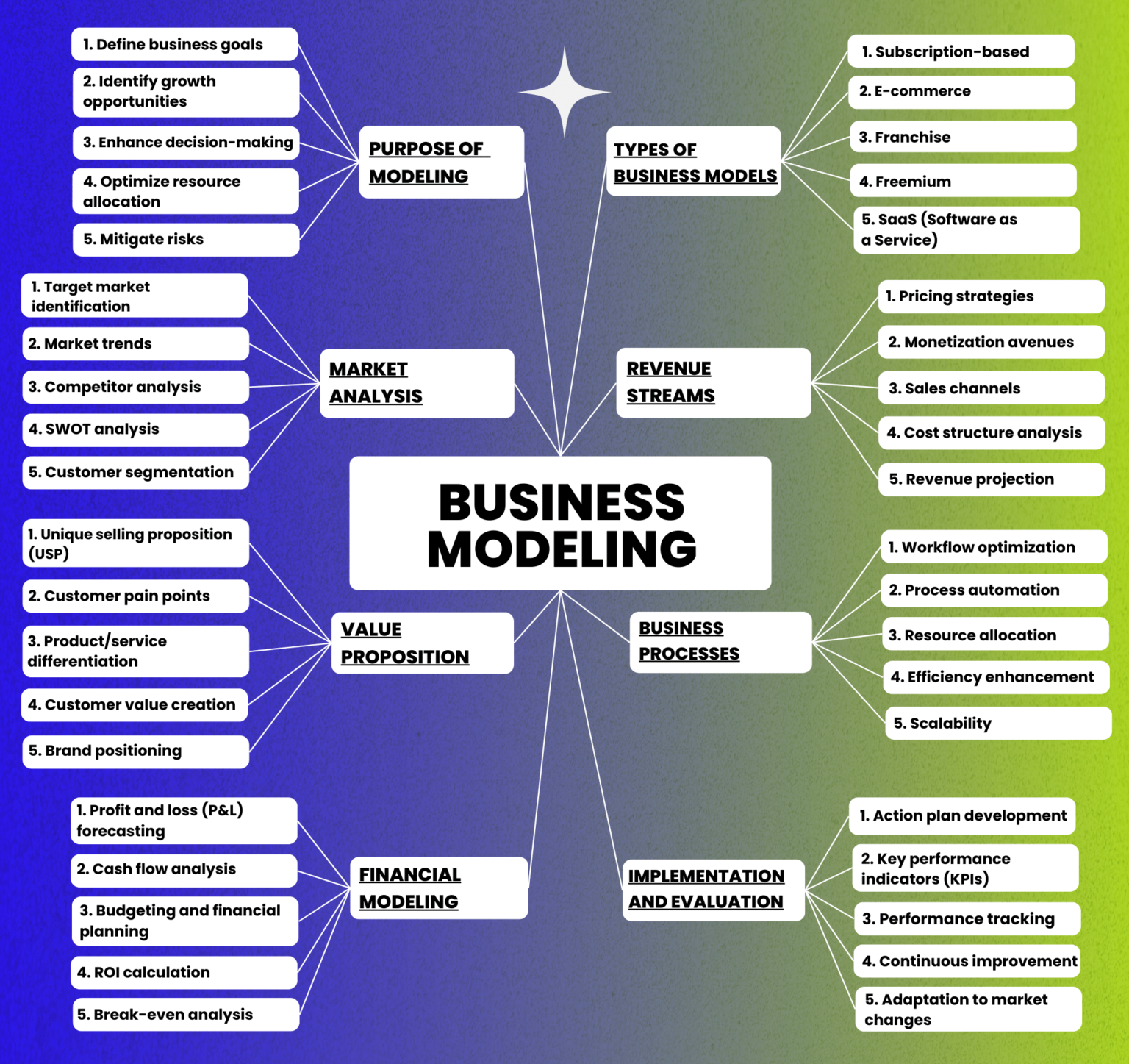Business modeling is a structured process that provides a clear framework for understanding how a business operates, creates value, and generates revenue. It involves analyzing key components such as core activities, customer relationships, and cost structures to identify the most efficient ways to achieve organizational goals. By visualizing the connections between these elements, business modeling equips decision-makers with actionable insights, enabling them to optimize operations, allocate resources effectively, and develop strategies that foster long-term success.
A well-designed business model serves as a critical blueprint for the operation, growth, and sustainability of any successful enterprise. Below, we will explore the core components that form the foundation of a robust business model. These elements collectively shape the strategy, resource allocation, and customer engagement processes that drive business success.
The Key Components of a Business Model:
- Value Proposition
This defines the unique value your product or service provides to customers. It addresses the specific problems you solve or the benefits you deliver, setting your offering apart from competitors. - Customer Segments
The specific groups of people or organizations that your business targets as customers. Effective segmentation ensures that marketing strategies and value propositions are aligned with the specific needs and behaviors of these groups. - Channels
The methods and platforms through which a business delivers its products or services to customers. These can include physical locations, online platforms, or through intermediaries. - Customer Relationships
This defines the strategies and methods a business uses to manage interactions with its customers to maintain satisfaction, loyalty, and engagement. These include approaches such as personalized customer support, community engagement, and loyalty programs. - Revenue Streams
The means through which your business generates income. This could involve direct sales, subscriptions, licensing fees, or advertising revenues, and includes the pricing strategies associated with them. - Key Resources
The essential assets a business needs to function and deliver its value proposition. Examples include physical assets, intellectual property, financial capital, and skilled personnel. - Key Activities
The critical tasks a business must perform to create, market, and deliver its products or services. This includes production, logistics, marketing, and customer support. - Key Partnerships
External entities or organizations that support a business’s operations, often by providing resources, sharing risks, or enhancing efficiency. Examples include suppliers, distributors, or strategic alliances. - Cost Structure
The breakdown of all expenses incurred in operating a business, including fixed costs (e.g., rent, salaries) and variable costs (e.g., production materials), with opportunities for cost reduction.
Bringing it Together
These components are frequently represented through visual frameworks like the Business Model Canvas, which serves as an effective tool for illustrating the interconnected aspects of value creation, delivery, and capture. By leveraging such tools, organizations can identify synergies between components, uncover inefficiencies, and align their strategies more effectively. This iterative refinement process empowers businesses to develop models that are not only resilient to external pressures but also capable of evolving with market trends.
A business model describes the fundamental logic of how a company operates and generates value. It focuses on key components such as value propositions, customers, revenue streams, and costs, often represented visually. A business plan, however, translates this model into a detailed, actionable strategy, including specific goals, timelines, financial projections, and operational plans. Simply put, the business model answers «what» and «how» the business works, while the business plan addresses «when», «who», and «how much» to achieve defined objectives.
Business modeling helps attract funding by clearly articulating the mechanisms through which your business creates value, serves customers, and generates revenue. It provides potential investors with a framework to evaluate your competitive advantage, market fit, and financial sustainability. A well-defined business model also demonstrates your understanding of key risks, costs, and opportunities, showcasing a strategic and well-thought-out plan for growth. This increases investor confidence in your ability to deliver measurable results and a solid return on investment.
To test and validate your business model before fully implementing it, follow this structured step-by-step approach:
- Market Research – Begin by analyzing the market to confirm demand for your product or service. Study your target audience to understand their needs and preferences while assessing competitors to identify market gaps or opportunities.
- Build a Prototype or MVP – Create a simplified version of your product, focusing on its core features. The MVP allows you to demonstrate value with minimal investment and test whether your solution meets customer expectations.
- Engage Early Customers – Share your MVP or prototype with early adopters, who are often more open to providing constructive feedback. Use tools like surveys, one-on-one interviews, and pilot programs to gather insights into what works, what doesn’t, and where improvements are needed.
- Measure Key Metrics – Use quantitative data to validate your assumptions. Monitor metrics like customer conversion rates, acquisition costs, and retention rates. For revenue testing, assess customer willingness to pay through experiments like pre-sales or pilot pricing strategies.
- Iterate and Adjust – Use the insights you’ve gathered to refine your business model. Adjust the value proposition, target segments, or revenue approach as needed. This iterative process ensures you validate key aspects of your model before committing to a full launch, saving time, money, and resources.
Developing a business model can be a complex process, and businesses often encounter several common challenges along the way. These challenges include:
Identifying the Right Value Proposition
Businesses often struggle to clearly define the unique value their product or service offers to customers. Misunderstanding customer needs or failing to differentiate from competitors can result in a weak value proposition.Targeting the Right Customer Segments
Determining the most relevant audience for the business can be challenging. Companies may overestimate the size of their market or misalign their offerings with the needs and preferences of their target customers.Achieving Financial Viability
Developing a revenue model that balances pricing, costs, and profitability is a common challenge. Businesses may underestimate costs, misprice their offerings, or fail to identify sustainable revenue streams.Aligning Resources and Activities
Ensuring that key resources and activities align with the business’s strategic goals can be difficult. Limited access to funding, skilled talent, or critical partnerships often hinders a company’s ability to execute its business model effectively.Adapting to Market Changes
Businesses must constantly adjust their models to keep up with evolving market conditions, competition, and customer behavior. Failure to adapt can render even well-planned models obsolete.
Navigating these challenges requires careful planning, research, and a willingness to adapt and iterate as the business model evolves and matures.
Tracking key performance indicators (KPIs) related to your business model is crucial for assessing its effectiveness and making informed decisions. Here are some essential KPIs to consider:
Revenue Streams
Measure the total revenue generated from different sources, such as product sales, subscriptions, or services. Tracking revenue streams helps assess which channels or offerings contribute most to your income.Customer Acquisition Cost (CAC)
CAC represents the cost of acquiring a new customer. It includes marketing, sales, and related expenses. A lower CAC relative to revenue indicates efficient customer acquisition strategies.Customer Lifetime Value (CLV)
CLV measures the total revenue a business can expect from a single customer over their relationship with the company. Comparing CLV to CAC helps determine long-term profitability.Churn Rate
The churn rate indicates the percentage of customers who stop using your product or service over a specific period. A high churn rate signals issues with customer satisfaction or value delivery.Gross Margin
Gross margin reflects the difference between revenue and the direct costs of producing goods or services. It indicates how efficiently a business generates profit from its operations.Conversion Rate
The conversion rate measures how effectively you turn leads, visitors, or potential customers into paying clients. This metric is critical for understanding the effectiveness of sales and marketing efforts.Operating Costs
Monitoring fixed and variable costs helps ensure your cost structure remains sustainable. Keeping expenses in line with revenue is essential for financial stability.Break-Even Point
The break-even point represents the level of sales at which total revenue equals total costs. It helps businesses understand the minimum performance required to cover expenses.Retention Rate
The retention rate measures the percentage of customers who continue to engage with your business over time. High retention reflects strong customer relationships and consistent value delivery.Cash Flow
Cash flow measures the net amount of cash moving into and out of the business. Positive cash flow is critical for maintaining day-to-day operations and funding growth initiatives.
Select the KPIs that align most closely with your business goals and objectives. Regularly monitoring and analyzing these metrics can help you make data-driven decisions and optimize your business model for success.

Business modeling serves as a strategic compass for modern enterprises, guiding them through the complexities of today’s competitive landscape. This structured approach to planning and decision-making empowers businesses to achieve clarity, optimize resources, and proactively address challenges. Let’s delve into the invaluable value that business modeling brings to enterprises.
1. Strategic Clarity:
• Business modeling helps businesses gain a clear understanding of their core objectives, strategies, and long-term goals. It provides a structured framework for aligning various aspects of the business, ensuring that all efforts are directed toward a common vision.
2. Risk Mitigation:
• Through scenario analysis and forecasting, business modeling allows businesses to identify potential risks and challenges. This proactive approach helps in developing risk mitigation strategies, making businesses more resilient to unforeseen circumstances.
3. Resource Optimization:
• By modeling resource allocation, businesses can optimize their use of capital, labor, and other resources. This leads to cost savings, improved efficiency, and better utilization of available assets.
4. Informed Decision-Making:
• Business modeling provides a data-driven foundation for decision-making. It enables businesses to assess the impact of different strategies, changes in market conditions, or investment decisions before implementation, reducing the likelihood of costly mistakes.
5. Improved Communication:
• A well-constructed business model serves as a communication tool for internal and external stakeholders. It helps convey the business’s strategy, value proposition, and financial outlook, fostering transparency and alignment among teams and investors.
6. Sustainable Growth:
• Business modeling encourages a forward-thinking approach to growth. By testing various growth scenarios, businesses can identify sustainable paths to expansion while avoiding strategies that might lead to overextension or instability.
In summary, business modeling adds significant value to businesses by providing strategic clarity, reducing risks, optimizing resources, supporting informed decision-making, enhancing communication, and promoting sustainable growth. It is a valuable tool for businesses of all sizes and industries seeking to achieve long-term success.
In the ever-evolving world of business, the strategic use of data and insights has become paramount. Yet, some businesses choose to sideline a critical tool: business modeling. Neglecting this essential practice can have far-reaching consequences, impacting a company’s ability to navigate challenges, seize opportunities, and achieve sustainable growth.
1. Lack of Strategic Clarity:
• Without a well-defined business model, companies may lack a clear roadmap for achieving their objectives. This can lead to confusion among teams, misalignment with company goals, and inefficient resource allocation.
2. Limited Decision-Making Insights:
• Neglecting business modeling deprives decision-makers of valuable insights. A structured model provides a data-driven foundation for evaluating potential strategies, risks, and opportunities, ensuring that decisions are based on evidence rather than intuition.
3. Inefficient Resource Allocation
• Business modeling aids in optimizing resource allocation by assessing the most effective use of capital, human resources, and time. Without it, businesses may waste resources on unproductive activities, hindering profitability.
4. Risk Unpreparedness:
• Neglecting to model potential risks and contingencies can leave businesses vulnerable. Without a proactive approach to risk management, companies may struggle to respond effectively to unforeseen challenges, potentially leading to financial setbacks.
5. Missed Growth Opportunities:
• Business modeling helps identify growth avenues and assess their feasibility. Companies that neglect modeling may miss out on expansion possibilities, hindering their competitiveness in the market.
6. Stunted Adaptability:
• In today’s rapidly changing business environment, adaptability is key to survival. Neglecting business modeling can make it difficult for companies to pivot in response to market shifts, technological advancements, or competitive pressures.
In summary, the downside of neglecting business modeling encompasses a lack of strategic clarity, limited decision-making insights, inefficient resource allocation, risk unpreparedness, missed growth opportunities, and stunted adaptability. Embracing business modeling is essential for businesses seeking to thrive in a dynamic and competitive landscape.

